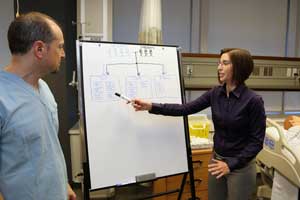 January 25, 2017 – Interdisciplinary research from U of T Engineering is helping us live longer, healthier lives. These projects from across our Faculty illustrate leading-edge innovations that will improve health care, from planning and prevention to diagnosis and treatment:
January 25, 2017 – Interdisciplinary research from U of T Engineering is helping us live longer, healthier lives. These projects from across our Faculty illustrate leading-edge innovations that will improve health care, from planning and prevention to diagnosis and treatment:
Optimizing surgical schedules
Long wait lists for elective surgeries are a major challenge in the Canadian health care system. According to Professor Dionne Aleman (MIE), pictured below, right, the problem may not necessarily be a lack of resources, but rather a result of not using the resources we have as efficiently as we could.
“Hospitals have rules that indicate who gets operated on when, but the schedules that result are sub-optimal,” she said. Aleman and her team are addressing this problem by building mathematical models that can optimize the matches between patients, surgeons and operating rooms to generate the most efficient schedule.
One technique the team uses involves pooling resources. Rather than each hospital maintaining its own waiting list, patients would be treated as a single large waiting list. Patients would be assigned to a given surgeon or operating room to minimize the time when resources are unused. Using mathematical optimization tools, the team has generated schedules that could increase the number of patients treated in a given time period by up to 30 per cent.
Aleman collaborates closely with Dr. David Urbach, a surgeon and senior scientist at the Toronto General Research Institute. Her models are based on data from Toronto General Hospital, Toronto Western Hospital and the Princess Margaret Cancer Centre.
“Right now we’re adding workload balancing into our models,” Aleman said. “We want to ensure that all surgeons and hospitals are being used to an equitable level.”
Some hospitals are already using patient pooling on a small scale, and Aleman hopes that her models will help the technique be applied more broadly.
“I like research that has a positive impact on the world,” she said. “In health care it’s very obvious to see how any improvements can have a wide-ranging impact, so it’s a very fulfilling type of work to do.”
Optimizing ambulance distribution and routing
In Toronto, the average response time for ambulances is six minutes. In Dhaka, Bangladesh, the 11th largest city in the world, it’s 60 to 80 minutes. Professor Timothy Chan (MIE) and his team are working to help close this health-services gap.
“Our research has two components: first, optimizing the locations of ambulances throughout the city, and second, routing them to the patients,” said Justin Boutilier, a PhD candidate in Chan’s lab.
In September 2015, Boutilier spent three weeks in Dhaka assessing the current situation. Collaborating with Moinul Hossain, a traffic engineer and professor from the Islamic University of Technology (IUT), Boutilier surveyed patients regarding emergency transportation to hospitals to better understand the current state of the system. He also distributed a GPS-based app to rental car drivers that will track driving speeds and help map traffic patterns in the city.
All this information will be fed into a computer optimization model, which will test out hundreds of possible scenarios before arriving at an ideal distribution of ambulances across the city. The data will also be used to develop an app that provides real-time recommendations to drivers on the fastest route. In a city where it is not the cultural norm to yield to ambulances — and where there is little room to move aside anyway — avoiding busy streets can mean the difference between life and death.
Boutilier and Chan will also evaluate other forms of transportation, such as three-wheeled cabs or rickshaws, in order to address issues with reaching patients in areas without adequate access to ambulance transport, such as slums. They hope their approach can bring significant health benefits for the citizens of developing countries.
“There is a long history of using operations research to improve emergency medical services in North America, but in developing countries many of these ideas are still very new,” Chan said. “I think we can make a big impact there.”
Read more at U of T Engineering News. This article originally appeared in the 2016 issue of Skulematters magazine.